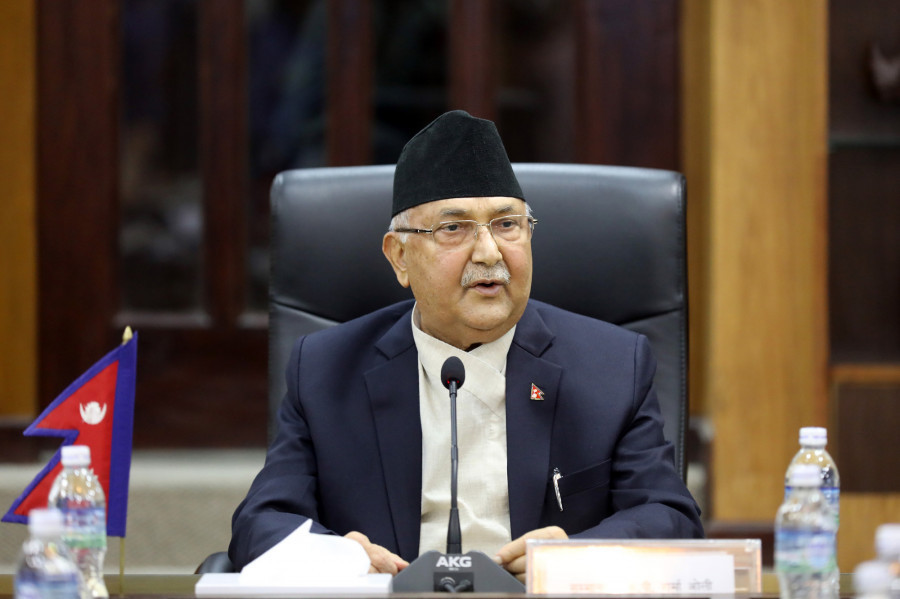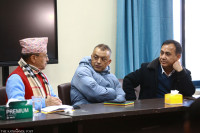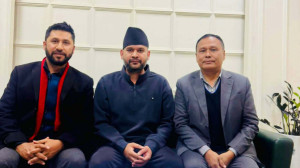Politics
Oli argues House dissolution a political move, not a matter of judicial review
Constitutional experts say the prime minister either doesn’t understand the constitution or he is twisting facts and constitutional provisions to defend his action.
Tika R Pradhan
KP Sharma Oli, who has been reduced to a caretaker prime minister since December 20, has defended his move of dissolving the House of Representatives, saying it was a political move and that it does not warrant a judicial review.
Responding to the Supreme Court’s December 25 show-cause notice, Oli furnished his response, through the Office of the Attorney General, on Sunday.
“Both the acts—recommending the dissolution of the House and its dissolution [by the President]—are purely political decisions. The Supreme Court itself has set a principle that on such issues, questions of constitutional and legal validity must not be the matter of judicial review,” states the 11-page response from Oli to the Supreme Court.
“In the face of growing conflict within the party, I could not see that the government would be able to fulfil the promises made through our election manifesto.”
Oli argues that he was forced to seek a fresh mandate, as the government was held hostage to infighting in the party. After dissolving the House, Oli has called snap polls for April 30 and May 10.
Oli claims that his move was driven by “the doctrine of necessity”, as the endless problems created in the party affected the government and Parliament.
Amid growing infighting in his Nepal Communist Party, Oli on December 20 recommended that the President dissolve the House of Representatives. President Bidya Devi Bhandari dissolved the House the same day. Since then, Oli has been arguing that he was forced to take the drastic step in the face of the difficulties created by his opponents in the party—Pushpa Kamal Dahal, Madhav Kumar Nepal and others—in performing his job.
Two days after Oli’s move, the Nepal Communist Party split on December 22. The Dahal-Nepal faction has taken to the streets, while experts on constitutional affairs have described Oli’s move as unconstitutional, saying the constitution does not allow a majority prime minister to dissolve the House.
As many as 13 writs have been filed at the Supreme Court, challenging Oli’s House dissolution.
After conducting a hearing on 12 writs, Chief Justice Cholendra Shumsher Rana on December 23 had sent all of them to the Constitutional Bench. One writ was directly sent to the Constitutional Bench.
On December 25, the Rana-led Constitutional Bench, which had Justices Hari Krishna Karki, Bishowambhar Prasad Shrestha, Anil Kumar Sinha and Tej Bahadur KC as members, issued a show-cause notice to the Office of the Prime Minister and the Council of Ministers and the Office of the President, sought an amicus curiae and demanded from the Speaker what time a no-confidence motion was registered at the Parliament Secretariat against the prime minister.
In his response, Oli said that the resumption of the winter session of the National Assembly is proof that he did not have any malafide intention in dissolving the House of Representatives.
Oli had recommended prorogation of the federal parliament on July 2.
The winter session of the upper house resumed on January 1, 12 days after he dissolved the lower house.
He has also reiterated what he has been publicly claiming that Article 76 (7), which says the House could be dissolved only when an alternative government is not possible, saying that since he commanded the majority in the 174-strong Parliamentary Party, there was no possibility of forming another government.
But with the Nepal Communist Party split and a no-confidence motion against him registered by then lawmakers of the ruling party, it is unclear whether Oli would still have the support of a majority of Parliamentary Party members.
Balaram KC, a former Supreme Court justice, however, dismissed Oli’s arguments, saying that he has either not understood the constitution or is twisting the facts.
“When the constitution has clearly stated on what grounds the prime minister can dissolve Parliament, Oli’s move is not a political question but a constitutional one,” KC told the Post. “Personal arguments and grudges cannot be presented as one’s defence in the court of law.”
KC said the House dissolution is clearly an issue that warrants a judicial review.
Earlier incidents of House dissolution by prime ministers GP Koirala, Manmohan Adhikari, Surya Bahadur Thapa and Sher Bahadur Deuba too had reached the Supreme Court, even though those moves were made under the 1990 constitution.
The 1990 constitution had clear provisions allowing the prime minister to dissolve the House.
The 2015 constitution, according to its drafters, did not include the provision of allowing a majority prime minister to dissolve the House to ensure stability.
While dissolving Parliament, the Office of the President had invoked articles 76(7) and 85 (1) of the constitution.
Article 76 (7) allows the dissolution of Parliament only when all options to form a government through the support of a majority of the members of the House of Representatives have been exhausted.
With regards to the term of House of Representatives, Article 85 (1) states that unless dissolved earlier pursuant to this constitution, the term of the House of Representatives shall be of five years.
Chandra Kanta Gyawali, a senior advocate who specialises on constitutional law, said that the 1990 constitution had given political right to the prime minister to dissolve Parliament.
“But the current constitution does not provide such a ground to a majority prime minister. So Oli’s move does demand a judicial review,” Gyawali told the Post. “Oli, as a majority prime minister, has encroached upon the jurisdiction of the fourth prime minister imagined by the constitution.”
Responding to the Supreme Court, Speaker Agni Sapkota also has furnished an explanation.
According to an official at the Speaker’s secretariat, Sapkota has responded to the court saying that Oli as a majority prime minister does not have the authority to dissolve the House.
“In the present context, our constitution has not given any right to the prime minister to dissolve the House,” a member of Sapkota’s secretariat told the Post quoting from his response to the court. “As long as there are alternatives to form a new government through Parliament, the prime minister cannot dissolve the House.”
As sought by the Constitutional Bench, the Office of the President too has furnished its clarification.
According to Bhesh Raj Adhikary, chief personal secretary of the President, the Office of the President in its brief statement said that it endorsed the recommendation of the executive as per the existing constitutional provisions, as the “recommendation was in line with the constitution”.
As per the demand of the Constitutional Bench for an amicus curiae, Nepal Bar Association has decided to send Badri Bahadur Karki, Satish Krishna Kharel and Bijay Kanta Mainali and the Supreme Court Bar has named Khagendra Adhikari and its recently elected chairman Purna Man Shakya as the “friend of court.”
An amicus curiae is a group of experts comprising lawyers and experts on the constitution called by the Supreme Court whenever it considers that the issue it is looking into is a serious one and the view of experts would be helpful.
Such experts are not a party to a particular litigation but they are permitted by the court to advise it in respect to some matters of law that directly affect the case in question.
The next hearing has been scheduled for Wednesday. The hearing is expected to continue until the lawyers from both sides—the petitioners and defendants—complete their arguments.
Authorities at the Supreme Court said they have received all the documents from the defendants as well as the Speaker.
“All the documents came at the last hour so we could get time just to register them,” said Bhadrakali Pokhrel, spokesperson for the Supreme Court.




 16.29°C Kathmandu
16.29°C Kathmandu















